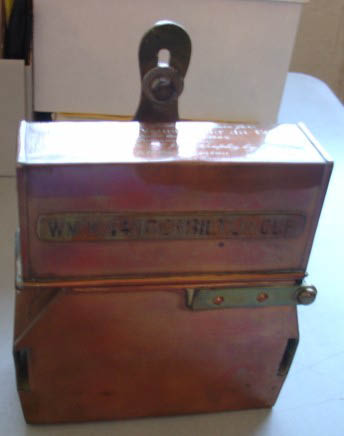The Drop Box Mystery at The Henry Ford

Leslie Mio, Assistant Registrar at The Henry Ford, recently sent this email to me:
"I am working on cataloging a sealed brass box. According to the donors (the Long Island Automobile Club), "These boxes . . . were used for signatures, so that Gentlemen Drivers, could not substitute Professional Drivers, in the Vanderbilt Cup Races." [letter to Henry Ford from Joseph F. Cox, Welfare Director, Long Island Automobile Club, dated January 15, 1936]. However, it seems more likely to be the drop box you refer to in your December 30, 2008 post. I hope you can definitively identify (the box) for me.
Leslie, your drop box was used on a racer during the 1904 Vanderbilt Cup Race. The above matching drop box is from the Suffolk County Vanderbilt Museum and was a gift given to William K. Vanderbilt Jr.. The inscription on the box documents that this box was used on the winning #7 Panhard during the race. Also note, the matching "Wm. K. Vanderbilt Jr. Cup" engravings on the front of both boxes.
The drop boxes were only used in the 1904 Vanderbilt Cup Race when the 30-mile course included control stops in in the more populated villages of Hicksville and Hempstead. Each racer had to stop every lap in these two areas, but the time spent in the controls did not figure into the running time on the course. Running time was calculated by subtracting control time from elapsed time, and this determined the finishing positions.
As shown above, a heavy leather strap affixed a sealed drop box of burnished copper to each car, and time cards were inserted through a chute. There was an outer lid to the box held shut by a clasp. This lid protected the contents from dust and dirt. After opening the lid, timers then inserted the cards through the chute, much like a mailbox.
When the cars were sent off at two minute intervals at the start, the time was recorded and dropped in the box. Then, at the Hicksville Control, the drivers were required to stop between two tapes 25 feet apart, and, upon doing so, their arrival time was recorded and handed to an escort, who was on a bicycle. If a driver failed to come to a halt between the tapes, the clock kept running until they backed up and stopped. In Hicksville, they were required to spend three minutes in control, and in Hempstead, six minutes. After that, their departure time was recorded on the card and dropped in the box. The entrance and exit times were then reported to the officials’ grandstand by telephone for consolidated record keeping and race tracking.



Comments